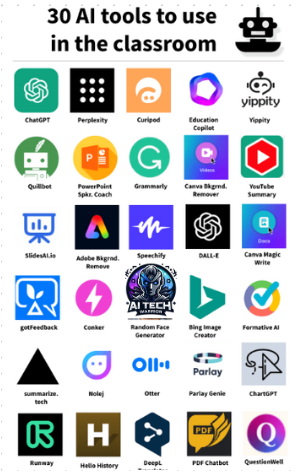AI Tools In The Classroom
My exploration of AI tools in English as a Second Language (ESL) classrooms starts with a simple observation: technology is no longer just an option in education; it’s an absolute necessity.
The integration of artificial intelligence (AI) into ESL settings sheds new light on how we approach language learning. It enables a learning environment rich with possibilities that were once beyond reach.
The compelling reasons for incorporating AI into ESL education stem from its unique benefits. AI offers tailored experiences that adapt to their learning pace and style, which is critical in mastering a new language.
In a nutshell, the students love the interactive experience that AI offers, along with the tech-driven experience.
Conversely, teachers gain invaluable insights into student progress, allowing them to fine-tune lesson plans and focus on areas where students struggle the most.
Learning with AI
The Synergy Between Language Learning and AI.
The synergy between AI and language learning extends well beyond the limits of traditional methods. Where textbooks and static lessons falter, AI swoops in with dynamic, interactive experiences that make learning a language as engaging as it is effective. This technology isn’t just about replacing old tools—it’s about enhancing the entire pedagogical approach.
As we delve into the myriad applications of AI in the ESL classroom, we’ll explore how these tools not only support but elevate the learning journey. Students benefit from immediate feedback, a cornerstone of efficient learning. Meanwhile, teachers can harness the power of analytics to illuminate the path forward, ensuring that every lesson leads to substantial progress.
Segueing into the next section, it becomes increasingly clear that AI isn’t just a supplementary resource—it’s transforming the way language is taught and learned. With the introduction of AI-powered language learning assistance, the potential to redefine ESL education is at our fingertips.
Click this Link to Read about more Tech and Online classroom tools I use for free.
AI-Powered Language Learning Assistance
Imagine an assistant that’s available 24/7, never gets tired and is equipped with an understanding of the nuances of English, from pronunciation to syntax. That’s the reality with AI in ESL classrooms. AI-powered language learning tools are changing the game by offering students instant feedback and tailored experiences that adapt to their skill level.
One of the most significant advantages is the capability of speech recognition technology. It allows students to speak naturally, recognize speech patterns, and provide real-time corrections. This immediate reinforcement helps them adjust their pronunciation, improve fluency, and gain confidence without the pressure of a classroom environment.
Natural language processing.
However, speaking is just one part of the puzzle. AI’s Natural Language Processing, or NLP for short, is a driving force in developing reading and writing skills. NLP technology can analyze text input, suggest context-based corrections, and even mimic conversational English to a remarkable degree, offering a comprehensive and interactive learning experience.
These powerful tools don’t just mimic human tutors; in some instances, they surpass them with the ability to handle many tasks at once, ensuring no student falls behind. A teacher can only focus on one student at a time, but AI scales its attention to the needs of each individual learner, ensuring focused practice that’s hard to replicate in traditional classroom settings.
The Best AI Tools for Engaging ESL Classrooms
Nailing down the right tech tools can transform an ESL classroom into a lively hub of language acquisition. Let’s cut to the chase. Here are some AI tools that have proven their worth:
First up, ‘Duolingo‘ – the well-known language learning app. Its AI algorithms adapt to individual learning styles, making practice fun and accessible.
Next, there’s ‘Rosetta Stone’. It leverages AI to provide an immersive learning experience, focusing on full language immersion rather than translation and memorization.
And “Mondly” is a good all-round language learning tool as well.
‘Chatbots’ also deserve mention. They can be excellent conversational partners, offering endless dialogue opportunities without the pressure of a human audience.. ( Although I do not use them and will not provide a link)
‘Quillbot” is a great paraphrasing tool that can help show students how to rearrange a script.
‘Grammarly” is more geared toward writing development, with AI providing real-time grammar, punctuation, and style corrections.
For teachers, ‘Quizlet’ and its AI feature, Quizlet Learn, can be handy tools. They help create learning materials and track student progress.
And we can’t overlook ‘Google Translate’, which is evolving with AI. It’s not just a translation tool; it’s becoming a companion for understanding and learning languages.
Note, though, AI tools are supplements, not replacements. The human element in language learning is irreplaceable, but these tools offer valuable support.
I use these tools frequently every month and find the free versions are suitable for 90% of the work you need done. Chatbots are the only thing I have not used, but I know of some teachers who are using them effectively, thus the inclusion.

Fostering a Collaborative Learning Environment with AI
I’ve seen firsthand the dynamic shift AI can introduce in an ESL classroom. By leveraging these advanced tools, educators can not only facilitate individualized learning but also cultivate a spirit of collaboration among students with diverse linguistic backgrounds. AI doesn’t replace the traditional classroom; it augments it, making language learning a shared, interactive, and often joyous endeavor.
One of the remarkable aspects of integrating AI into language instruction is its capacity to engage students in peer-to-peer interactions. Language learning is inherently social, and AI-driven games and collaborative activities can often mirror natural linguistic exchanges more closely than traditional drills. Through these interactive experiences, students are encouraged to communicate, negotiate meaning, and build language skills together.
Beyond the impact on students, AI tools also offer support for teachers. They’re no longer the sole source of language input or feedback—the AI shares that role, allowing educators to focus on facilitating discussions, managing group dynamics, and tailoring lessons to the evolving needs of their class. The ripple effect is significant; this allows for classroom environments where every student’s voice is heard and valued.
From my interactions with other educators who incorporate AI into their teaching, a consensus emerges: the most effective application of AI in ESL classrooms comes from teachers who blend its capabilities with their expertise. You can’t simply introduce a new tool and expect magic. It requires careful planning, a clear understanding of educational objectives, and an earnest desire to enhance student engagement.
Final Thoughts
In closing, AI tools are a powerful complement to the ESL teacher’s arsenal, promising innovative pathways to language acquisition. With a thoughtful approach to their deployment, these tools can undoubtedly help build not just language proficiency but also a classroom environment rich with interaction, support, and shared learning experiences.
A lot is happening very quickly in the world of online education, and there’s a lot of opportunity to experiment with new content and teaching methods.
Adaptability is your friend here; you can always adjust your approach down the road.
My name is Steve, I hope this helps.
If you like this check out my blogs on speech -to -script and script-to-speech tools on my YouTube site.

Please support me on Ko-Fi so I can continue to bring you FREE resources like this.
Any or all links on this site may be affiliate links, and if you purchase something through those links I will make a small commission on them.
There will be no extra cost to you and at times due to my affiliation, you could actually save money.
You can read our full affiliate disclosure here.

